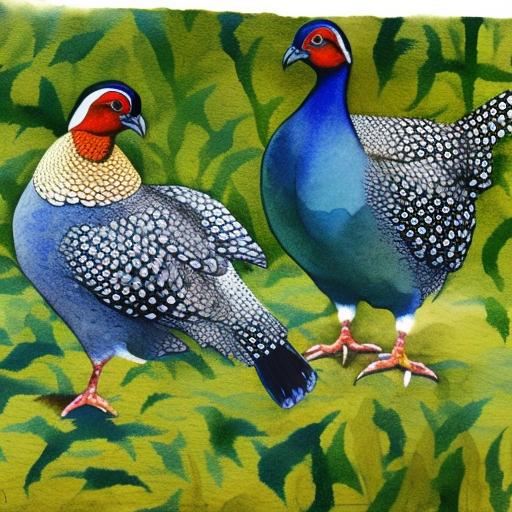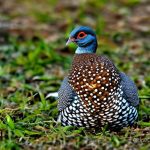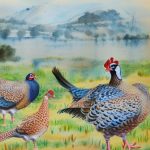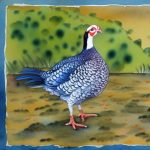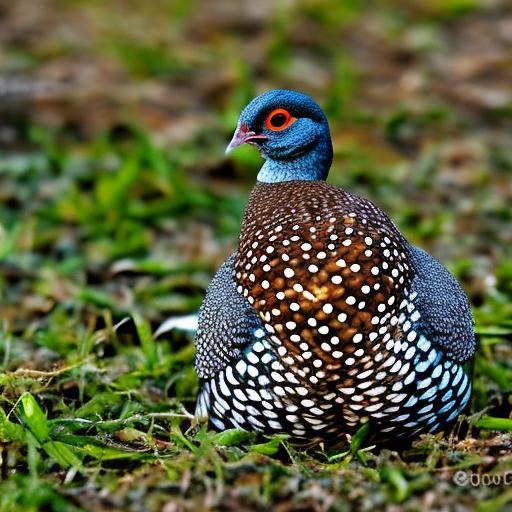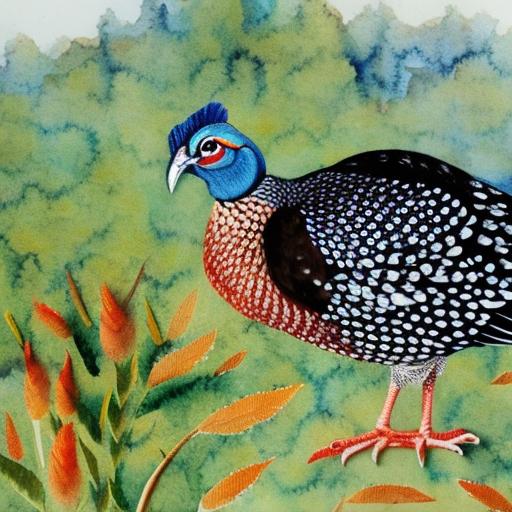Guinea fowl are known for their unique and striking color patterns, which make them a popular choice for both farmers and backyard poultry enthusiasts. These birds come in a wide range of colors, including pearl, lavender, royal purple, and coral blue, among others. The variety of colors and patterns in guinea fowl make them a fascinating subject for breeders who are interested in color genetics and breeding for specific color varieties. Understanding the genetics of guinea fowl colors is essential for breeders who want to produce birds with specific color traits. Breeding for specific color varieties in guinea fowl can be a rewarding and challenging endeavor, requiring careful selection and breeding practices to achieve the desired results.
Key Takeaways
- Guinea fowl come in a variety of colors, making them an attractive option for breeders.
- Understanding the genetics of guinea fowl colors is important for successful breeding.
- Breeding for specific color varieties requires careful selection and planning.
- Common color varieties in guinea fowl breeding include pearl, lavender, and royal purple.
- Successful guinea fowl color breeding requires attention to detail and patience.
Understanding the Genetics of Guinea Fowl Colors
The genetics of guinea fowl colors are complex and can be influenced by multiple genes. The most common colors in guinea fowl are pearl, lavender, royal purple, and coral blue, which are controlled by different sets of genes. The pearl color, for example, is controlled by a single gene, while lavender and royal purple colors are controlled by multiple genes. Understanding the inheritance patterns of these color genes is crucial for breeders who want to produce specific color varieties in their guinea fowl flocks. In addition to understanding the genetics of color, breeders must also consider other factors such as feather pattern and size when breeding for specific color varieties. By carefully selecting breeding stock with the desired color traits and understanding the inheritance patterns of color genes, breeders can work towards producing guinea fowl with consistent and desirable color varieties.
Breeding for Specific Color Varieties
Breeding for specific color varieties in guinea fowl requires careful selection of breeding stock and a thorough understanding of color genetics. Breeders should start by selecting birds with the desired color traits and using them as the foundation for their breeding program. By selecting birds with the desired color traits, breeders can increase the likelihood of producing offspring with the same color characteristics. It is important to note that breeding for specific color varieties may take several generations to achieve the desired results, as color genetics can be influenced by multiple genes. Additionally, breeders should also consider other factors such as feather pattern and size when selecting breeding stock to ensure that the offspring exhibit the desired color traits. By using selective breeding practices and understanding the genetics of guinea fowl colors, breeders can work towards producing birds with consistent and desirable color varieties.
Common Color Varieties in Guinea Fowl Breeding
There are several common color varieties in guinea fowl breeding, each with its own unique characteristics and genetic inheritance patterns. The pearl color variety is one of the most common in guinea fowl, characterized by a white base color with black spots or markings. The pearl color is controlled by a single gene, making it relatively straightforward to breed for this color variety. Another popular color variety is lavender, which is characterized by a light grayish-purple color. Lavender is controlled by multiple genes, making it more challenging to breed for this color variety. Royal purple is another sought-after color variety in guinea fowl, characterized by a deep purple hue with black spots or markings. Breeding for royal purple guinea fowl requires careful selection of breeding stock with the desired color traits and an understanding of the inheritance patterns of the genes that control this color variety. Coral blue is another common color variety in guinea fowl breeding, characterized by a light blue base color with black spots or markings. Breeding for coral blue guinea fowl also requires careful selection of breeding stock and an understanding of the genetics of this color variety.
Tips for Successful Guinea Fowl Color Breeding
Breeding for specific color varieties in guinea fowl requires careful planning and selection of breeding stock with the desired color traits. To increase the likelihood of producing offspring with the desired color characteristics, breeders should select birds with consistent and desirable color traits as the foundation for their breeding program. It is also important to understand the genetics of guinea fowl colors and the inheritance patterns of the genes that control these traits. By understanding the genetics of color, breeders can make informed decisions when selecting breeding stock and increase the likelihood of producing offspring with the desired color varieties. Additionally, breeders should be patient and persistent when breeding for specific color varieties, as it may take several generations to achieve the desired results. By using selective breeding practices and understanding the genetics of guinea fowl colors, breeders can work towards producing birds with consistent and desirable color varieties.
Challenges and Considerations in Guinea Fowl Color Breeding
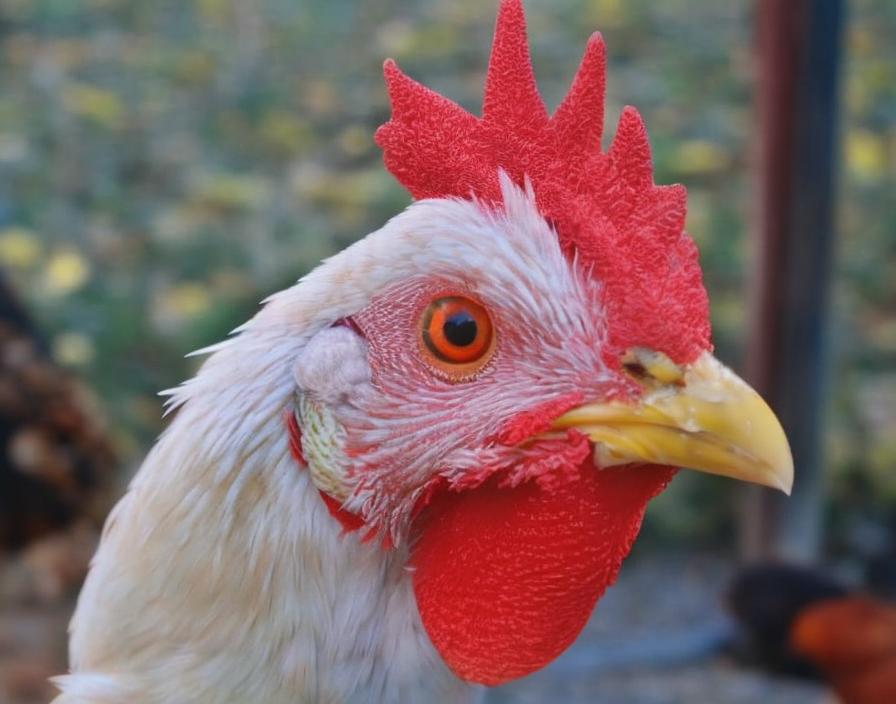
Breeding for specific color varieties in guinea fowl comes with its own set of challenges and considerations. One of the main challenges is understanding the complex genetics of guinea fowl colors, which can be influenced by multiple genes. Breeders must carefully select breeding stock with the desired color traits and have a thorough understanding of the inheritance patterns of these traits to achieve consistent results. Additionally, breeding for specific color varieties may take several generations to achieve the desired results, requiring patience and persistence on the part of the breeder. Another consideration is the potential for unexpected color variations to occur in offspring, even when breeding from birds with consistent and desirable color traits. Breeders should be prepared to cull birds that do not meet the desired color standards to maintain the integrity of their breeding program. Despite these challenges, with careful selection of breeding stock and a thorough understanding of color genetics, breeders can work towards producing guinea fowl with consistent and desirable color varieties.
Conclusion and Future Trends in Guinea Fowl Color Breeding
In conclusion, breeding for specific color varieties in guinea fowl can be a rewarding but challenging endeavor that requires careful selection of breeding stock and a thorough understanding of color genetics. By using selective breeding practices and understanding the inheritance patterns of color genes, breeders can work towards producing birds with consistent and desirable color varieties. Despite the challenges involved in guinea fowl color breeding, with patience and persistence, breeders can achieve their desired results over time. In the future, advancements in genetic research may provide breeders with new tools and techniques for breeding specific color varieties in guinea fowl. Additionally, there may be an increased interest in preserving rare and unique color varieties through selective breeding practices. As breeders continue to work towards producing guinea fowl with consistent and desirable color varieties, the future looks bright for the world of guinea fowl color breeding.
If you’re interested in breeding guinea fowl colors, you may also want to check out this informative article on creating the perfect chicken coop at Poultry Wizard. A well-designed coop is essential for the health and happiness of your poultry, and this article provides valuable insights on how to achieve that.
FAQs
What are the different colors of guinea fowl?
Guinea fowl come in a variety of colors including pearl, lavender, royal purple, white, and pied (a combination of white and another color).
How do you breed for specific colors in guinea fowl?
Breeding for specific colors in guinea fowl involves selecting parent birds with the desired color traits and ensuring that they are genetically compatible to produce offspring with the desired colors.
Are certain colors of guinea fowl more desirable than others?
The desirability of guinea fowl colors can vary depending on personal preference and market demand. Some colors may be more popular for ornamental purposes, while others may be preferred for their unique and striking appearance.
Can guinea fowl colors change as they mature?
Yes, the colors of guinea fowl can change as they mature. Chicks may have different color patterns than their adult plumage, and some colors may become more vibrant or muted as the bird grows.
Are there specific breeding techniques for producing certain colors in guinea fowl?
Breeding for specific colors in guinea fowl may involve techniques such as selective breeding, genetic testing, and careful record-keeping to track the inheritance of color traits. It is important to understand the genetics of color inheritance in guinea fowl to effectively breed for specific colors.
Meet Walter, the feathered-friend fanatic of Florida! Nestled in the sunshine state, Walter struts through life with his feathered companions, clucking his way to happiness. With a coop that’s fancier than a five-star hotel, he’s the Don Juan of the chicken world. When he’s not teaching his hens to do the cha-cha, you’ll find him in a heated debate with his prized rooster, Sir Clucks-a-Lot. Walter’s poultry passion is no yolk; he’s the sunny-side-up guy you never knew you needed in your flock of friends!

